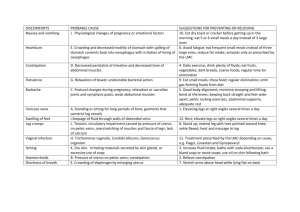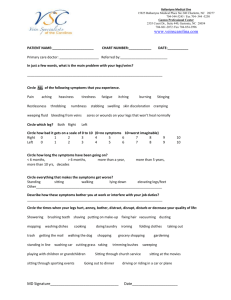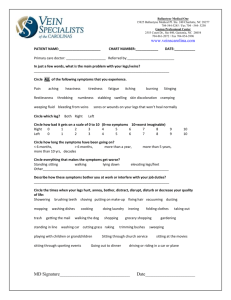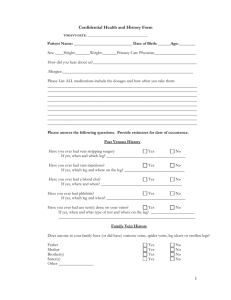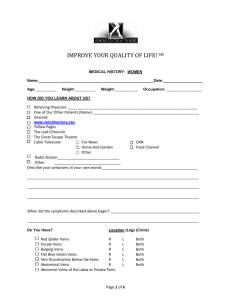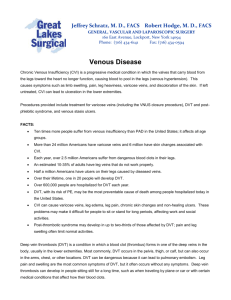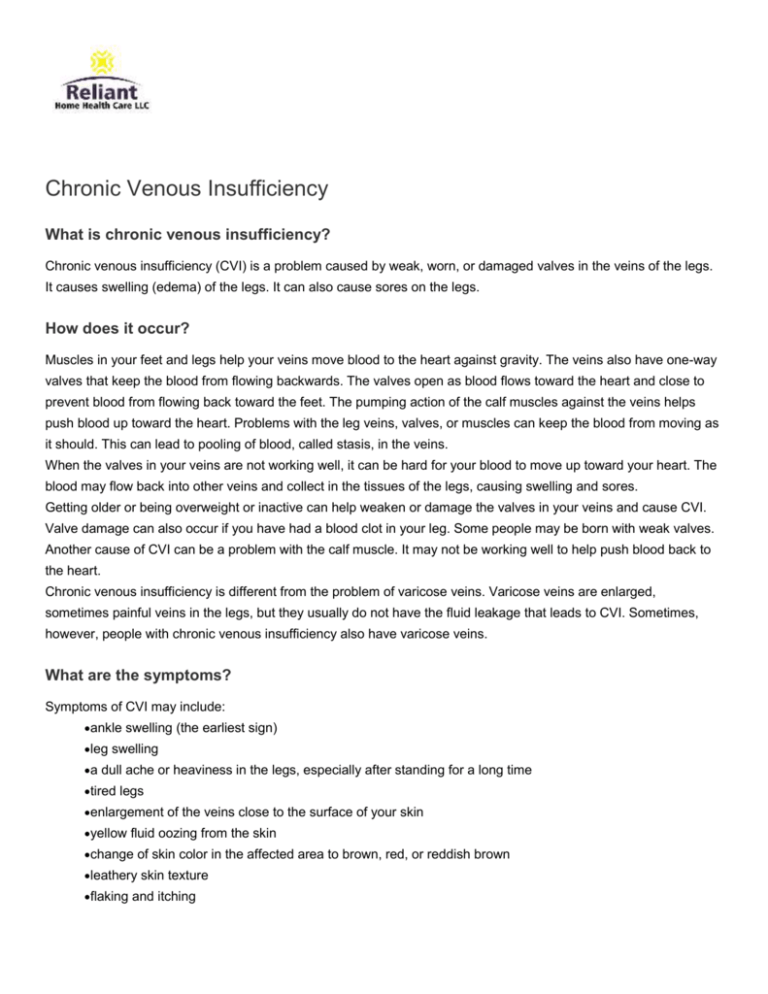
Chronic Venous Insufficiency
What is chronic venous insufficiency?
Chronic venous insufficiency (CVI) is a problem caused by weak, worn, or damaged valves in the veins of the legs.
It causes swelling (edema) of the legs. It can also cause sores on the legs.
How does it occur?
Muscles in your feet and legs help your veins move blood to the heart against gravity. The veins also have one-way
valves that keep the blood from flowing backwards. The valves open as blood flows toward the heart and close to
prevent blood from flowing back toward the feet. The pumping action of the calf muscles against the veins helps
push blood up toward the heart. Problems with the leg veins, valves, or muscles can keep the blood from moving as
it should. This can lead to pooling of blood, called stasis, in the veins.
When the valves in your veins are not working well, it can be hard for your blood to move up toward your heart. The
blood may flow back into other veins and collect in the tissues of the legs, causing swelling and sores.
Getting older or being overweight or inactive can help weaken or damage the valves in your veins and cause CVI.
Valve damage can also occur if you have had a blood clot in your leg. Some people may be born with weak valves.
Another cause of CVI can be a problem with the calf muscle. It may not be working well to help push blood back to
the heart.
Chronic venous insufficiency is different from the problem of varicose veins. Varicose veins are enlarged,
sometimes painful veins in the legs, but they usually do not have the fluid leakage that leads to CVI. Sometimes,
however, people with chronic venous insufficiency also have varicose veins.
What are the symptoms?
Symptoms of CVI may include:
ankle swelling (the earliest sign)
leg swelling
a dull ache or heaviness in the legs, especially after standing for a long time
tired legs
enlargement of the veins close to the surface of your skin
yellow fluid oozing from the skin
change of skin color in the affected area to brown, red, or reddish brown
leathery skin texture
flaking and itching
sores on your legs, often on or near the ankle.
Blood leaking into tissue around your veins may color your skin a reddish brown. The skin becomes dry, cracks, and
itches. Your skin can be damaged by these changes, causing a condition called venous stasis dermatitis. You may
get sores on your legs. The sores, called venous stasis ulcers, are usually located above the ankle on the inside of
the leg. The sores can get infected. Surrounding tissue may then get infected, causing a condition called cellulitis.
Cellulitis must be treated with antibiotics.
How is it diagnosed?
Your healthcare provider will ask about your medical history and examine your legs. The most common tests are
plethysmography, duplex ultrasound, and contrast venography.
IPG (impedance plethysmography) measures vein function in the arm or leg. Your healthcare provider or a
technologist will place a pressure cuff on your arm or leg and measure how fast the veins empty.
Duplex ultrasound uses high-frequency sound waves to make pictures. Sound waves are bounced off the
deep veins in an arm or leg. These echo pictures help find any blockages. Doppler ultrasound signals
measure how fast the blood flows through the veins.
Contrast venography is used when other tests do not give a definite answer. During venography a dye is
injected into a vein while X-ray pictures are taken. This test can usually show any blockages in your
veins.
How is it treated?
The goals of treatment are to reduce the pooling of blood and prevent sores.
Compression stockings can decrease pressure in the veins and prevent sores. These stockings are different
from the elastic stockings that may be used to treat a blood clot. They are specially made to fit each
person so that they put the most pressure near the ankles and the least pressure near the knees. You
should put the stockings on after your legs have been up for a while, for example, before you get out of
bed in the morning.
If you do not have any sores and no fluid is oozing out of the tissue:
o
An anti-itch cream (hydrocortisone) can be used as needed.
o
Creams such as zinc oxide may help protect the skin from cracking and inviting infection.
o
Your healthcare provider may recommend an antifungus cream because you have a higher risk of
getting a fungal infection.
If the skin is oozing (weeping) drops of fluid, special wet compresses are used until the weeping stops.
Sores are treated with layered compression bandages. Your healthcare provider can teach you how to put
on the 3 or 4 layers of different types of bandages. Elastic bandages are not used because they do not
provide enough pressure. If the ulcers get infected, your provider may prescribe antibiotics.
To allow pooled blood to drain, raise your legs above the level of your heart at set times throughout the day
(at least 30 minutes every 2 hours). At night, sleep with your feet raised about 6 inches by propping them
on pillows.
If these methods do not provide relief, your healthcare provider may recommend one of these types of surgery:
Sclerotherapy. Sclerotherapy involves injecting an irritating liquid into the veins. This causes the veins to
close and forces the blood to flow through healthier veins. This procedure makes your legs look better,
but it may cause worse problems later.
Vein ligation and stripping. During this surgery, one or more incisions (cuts) are made over the vein and it is
tied off (ligated). If several valves in the vein and the vein itself appear to be damaged, the diseased part
of the vein is removed (stripped).
Valvuloplasty. Valvuloplasty is surgery to repair the valves.
How long do the effects last?
CVI is a lifelong condition. Flare-ups of stasis dermatitis and stasis ulcers may come and go.
How can I help take care of myself?
Keep your legs up as much as possible when you are resting.
Avoid long periods of sitting or standing. Walking is better for blood flow. When you are sitting, avoid
crossing your legs or dangling your legs over the edge of a chair or bed.
Exercise your calf muscles, such as by walking. If you must sit for a long time, point and lift your toes 10 to
15 times every 30 minutes to keep the calves working.
Avoid wearing girdles, leg garters, and other tight-fitting garments.
Keep a healthy weight. If you are overweight, try to lose some weight.
Protect your feet and legs from injury, for example, by wearing comfortable, supportive shoes and socks.
Keep your skin clean, dry, and soft. Wash with a mild soap, dry carefully, and put an unscented lotion on
your legs right away if dryness has been a problem.
If you have compression stockings, wear them during the day.
Check the skin of your legs every day for signs of infection. These signs include:
o
an area that feels warmer than normal
o
new redness or a bigger area of redness
o
a change in the way the skin feels.
If you think you have a leg ulcer or infection, see your healthcare provider.
How can I help prevent chronic venous insufficiency?
To promote healthy veins, keep a healthy weight and activity level. Keep your calf muscles strong and active. Avoid
long periods of inactivity. If you have a family history of varicose veins, wear support stockings to help your veins
stay healthy.
© 2008 RelayHealth and/or its affiliates. All rights reserved.

